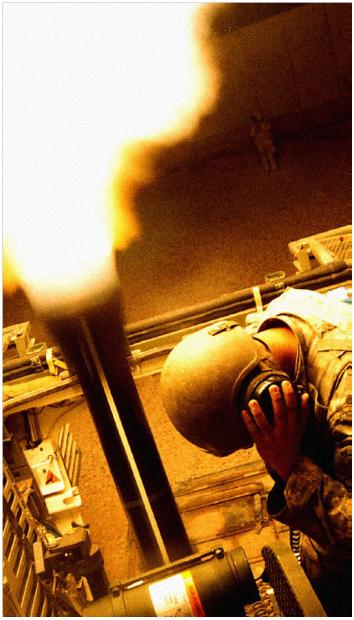MOMRP and TATRC Focus on Protection of Senses
Soldiers in the field have to be on the lookout for numerous threats that could result in impairment, or even complete loss, of their eyesight. Environmental exposure such as blast, laser, biohazard and chemical injuries all threaten the Warfighter's eyesight. Visual injuries can range anywhere from total vision loss in one or both eyes, to sensitivity to light and double vision. Soldiers have to be careful in protecting their hearing as well.
"Since 2009, the Telemedicine and Advanced Technology Research Center -- with support from the Congressionally Directed Medical Research Programs, Clinical and Rehabilitative Medicine Research Program, and other research and development programs -- has administered the Peer Reviewed Vision Research Program, which focuses on the mitigation and treatment of traumatic injuries, visual dysfunction associated with TBI, and visual systems diagnostic capabilities and assessment strategies," said Robert Read, program manager for Vision, Diabetes and Pain Research at TATRC.
The program searches for investigators engaging and assessing new technologies and therapies that address the ocular issues of Service members. Current research specifically targets the causes, effects, and treatment of eye damage with a common result: degeneration of the critical components of the eye, and impairment or loss of vision.
As program manager, Read oversees the purpose and status of all TATRC vision projects, ensuring that overall program goals are being met for cost, schedule and performance. Read has been working with scientists, clinicians and engineers for 11 years now, trying to solve problems associated with eye disease and trauma.
At the center of the TATRC vision program is a six-man eye team, including Read himself, which he refers to as the "eye guys."
These "eye guys" include: Colonel Donald Gagliano, MC, director of the Vision Center of Excellence; Robert Mazzoli, MD, associate director of the VCE; Lieutenant Colonel Michael Mines, MC, Department of Ophthalmology at the Walter Reed National Medical Center; Francis McVeigh, OD, Senior Clinical Consultant; and Marc Mitchell, GOR and project officer at TATRC.
"I am so fortunate to work with this amazing team because of their clinical, science and administrative expertise; they are brilliant when it comes to the eyes and vision system, but they are even better persons," said Read.
One of the most prevalent occupational injuries suffered by military Service members is auditory.
The Military Operational Medicine Research Program, created within the U.S. Army Medical Research and Materiel Command, focuses its research efforts on the prevention of the auditory and vestibular effects of exposure to blast, impulse noise, and intense continuous noise.
"The progress that the MOMRP has made is very substantial," said Dr. Richard Shoge, MOMRP blast injury portfolio manager.
"One important goal of the program is to ensure standards and preventative measures we support and recommend are thoroughly validated against properly designed experimental data. Our great research staff and multi-disciplinary network of military and civilian scientists have made headway in creating better ear protection equipment and guidelines, methods to assess hearing capabilities, and test devices to assess the risk of injury. Many questions still remain about the mechanisms of tinnitus and noise-induced hearing loss, but with the manpower and equipment we have in place, and continued support for neurosensory injury, we can adequately address these issues."
Several lines of research are being pursued to improve Warfighter hearing protection.
"We are supporting research to develop validated biomechanically based auditory standards to improve hearing conservation and guide development of better hearing protectors," explained Shoge. "Other active and future projects we support include quantification of acoustic and vestibular injury when exposed to acceleration, quick and portable ways to assess auditory and vestibular effects resulting from hazardous exposures, and computer modeling to predict the amount of hearing protection in known hazard environments."
The USAMRMC prides itself on "looking at the big picture" when investigating causes of hearing and vestibular injury.
"We do not only focus on hazardous noise from blast injuries, but also non-hazardous operational noises that result in symptoms such as stress, headaches and difficulty concentrating," said Shoge. "The program has made great strides in collaboration across all military branches and with industry and academia."
The medical problems being researched by the MOMRP not only apply to Soldiers, but to the civilian population as well. The hearing and protection standards working to be developed and validated by the program can be used to protect individuals both at work and at play.
"Another important goal of MOMRP and MRMC is investigating co-morbidity of injury," explained Shoge. "There are many disabilities showing a range of overlapping symptoms. With our research efforts, we envision that Soldiers and medical personnel in the field can not only reduce their risk of hearing and vestibular injury, but they may also make the best decision possible to prioritize ailments so the most pertinent problem can be addressed first, thus reducing further debilitation."
Both hearing and vision problems remain a large problem, not just in the military world, but in the civilian world as well. The MOMRP and TATRC Vision Research Program continue their efforts in seeking and delivering solutions in the hopes of giving back those senses that have been lost.















